#kennington road
Explore tagged Tumblr posts
Text


Kennington Road
8 notes
·
View notes
Text

📸 Grantham Road and Loughborough Estates + Battersea Power Station
#architecture#cityscape#london#original photographers#photography#urban#skyline#urban photography#blade runner#cyberpunk#south london#brutalism#social housing#dawson’s heights#dawson heights#one west point#charecroft estate#grantham road estate#george finch#cotton gardens estate#edrich house#kennington#loughborough estate#kemble house#kettley house#woolley house#richard seifert#battersea power station#stockwell#moon
70 notes
·
View notes
Photo
287 Kennington Road is where he lived with his father on order of the court for both Sydney (13) and Charlie (9 ), also in the home was his father’s “wife” Louise and her young son (whether he was the son of both Chaplin Sr and Louise is not known). Charlie lived in relative comfort compared to how he lived with his mother Hannah (she at this time was in an asylum). Hannah continually struggled to feed, clothe and provide a home for the boys despite her mental illness and all without benefit of financial support from Charles Chaplin Sr., though he was a successful Music Hall performer he continually refused to support his sons and wife Hannah
Charlie Chaplin notes in his autobiography from 1964: While living with his father and Louise he witnessed both of their alcoholic fueled violence. Louise would lock the boys out of the house at night and took a particular dislike to Sydney, Sydney to avoid Louise was not often there, Charlie was thrilled when a few months later his mother was released and the little family was reunited.
The childhood home that appears to have had the most impact on Charlie was 3 Pownall Terrace, long ago demolished. He tried to recreate the small sparsely furnished home with the slanted ceiling in both “Easy Street” & “The Kid”.









Charlie Chaplin in Lambeth, South London, where he grew up.
He visited his old home, 287 Kennington Road (bottom centre) and The Three Stags (centre), the pub where, as a boy, he saw his father for the last time.
214 notes
·
View notes
Text
Tomorrow Is a Long Time. Doctor Who. Rose Tyler, The Doctor, characters from multiple eras. Mature. Complete, posting weekly. Spoilers for The Giggle.
If today was not an endless highway, if tonight was not a crooked trail, if tomorrow wasn't such a long time, then lonesome would mean nothing to you at all. Rose Tyler, on the road to Journey's End.
She lands in a car park off Kennington Road, near the Tesco Express. Less than a mile from the Estate. It’s the dead of night at eight o’clock in the morning, and there are twenty-six alien planets in the sky.
The photo on Donna’s phone couldn’t prepare her for the terrible reality of it – the bone-deep sense of wrong she feels every time she glances up. The streets around her are in chaos, and she can hear them in the distance – Daleks shouting orders, killing anyone who refuses to obey. There’s no time to think about anything else.
“Should’ve nicked that matter-disrupter,” she says, and runs towards the screaming.
Chapter 8
#doctor who fic#rose tyler#bad wolf#fourteenth doctor#doctor/rose fic#doctor/rose#penultimate chapter!#next week I'll post the last chapter and the epilogue
20 notes
·
View notes
Text
As part 9 of The Sign of the Four in "Letters from Watson" opens, I am immediately fond of Mrs. Forrester, the employer of the awesome and adorable Mary Morstan. Her reaction to Watson's news about the case, during his polite afternoon call is what charms me.
“It is a romance!” cried Mrs. Forrester. “An injured lady, half a million in treasure, a black cannibal, and a wooden-legged ruffian. They take the place of the conventional dragon or wicked earl.”
She's genre-savvy! I'm imagining a charming rowhouse, but Camberwell, like the Brixton/Kennington setting of A Study in Scarlet, is in a part of Lambeth that's seen a lot of reconstruction as housing projects. (I am distracted by the presence of a Korean fried chicken takeaway on Camberwell New Road. Sweet-and-spicy chicken sounds really good right now.)
Miss Morstan is, of course, a better person than anyone else in the room.
“It is for Mr. Thaddeus Sholto that I am anxious,” she said. “Nothing else is of any consequence; but I think that he has behaved most kindly and honorably throughout. It is our duty to clear him of this dreadful and unfounded charge.”
His family has done her a great deal of harm, out of selfish motives, and he's been set up as ridiculous in the audience's eyes -- yet her thought is for his being treated fairly by the law regarding his brother's murder.
Organized, practical, difficult-to-frighten, compassionate Miss Morstan may be intended as a model of Victorian womanhood, but she's in no way a delicate blossom. I adore her.
Meanwhile, Holmes is off in search of a steam launch. It belatedly occurred to me that I have no idea what a steam launch is, other than something boat-like. It turns out to be a medium/small boat with a smoke stack, a cabin for its workings, and an awning if there's anything that benefits from shelter. Thames Steamers are historic passenger steam launches, so they're painted up smartly -- but ordinary steam launches hauling this-and-that were a feature of the Thames from 1815 or so. After railroad service started, the proportion of passengers versus cargo shifted in the direction of cargo.
Holmes' "rude sailor dress" features a "pea-jacket," later more commonly called a "pea coat." The pea coat, a heavy wool double-breasted jacket that ends at about crotch-length, was a standard part of naval attire in Europe and the U.S. from the 18th century until very recently. It also had a huge fashion moment in the 1960s, thanks in part to the Beatles. Fashion-focused people wax rhapsodic about pea coats. Macy's has one in stock, appropriately made by Nautica. (Not a rec, not an affiliate, just looking for a harmless example.)

Then Holmes... then Holmes... *giggles*... puts my face in my hands to stop giggling... Holmes then... looks up spirit gum and grease paint, as I don't think you can get either off without some sort of agent like baby oil... aw, who the heck cares, Holmes fools Watson and Athelney Jones. The great detective has a sense of humor!
(I recently watched the entire run of The Pretender and am working on season 3 of White Collar -- so I am inclined to let things go for the sake of a charming con man working for justice. Which Holmes is. Jones is wrong. Holmes would never have joined the police. Too limiting. Had his sense of justice not led him into consulting, he would have been a con man.)
The meal Holmes promises his guests is another interesting combination of high and low. There will be oysters, which were so common and cheap that they are roughly equivalent to chicken wings today. The brace of grouse -- a bird that's hunted but not farmed -- suggests Holmes has a friend in the countryside or access to a butcher who does. And the "something a little choice in white wine" is absolutely high-brow, possibly a present from a satisfied client.
We are going after criminals in a fast steam launch later, so I have high hopes of pursuit and grappling.
10 notes
·
View notes
Text
The Disappearance of Lady Frances Carfax pt 3
Last time we came to the conclusion that she's either dead or she's not dead. Much like Schrödinger's cat. Shlessinger's Lady Frances is in a state of superposition and is both dead and alive at the same time. However, the purchase of a coffin for what appears to be an entirely legal burial does suggest that she may not be in quite as much of a superposition as we might like.
It was opened immediately, and the figure of a tall woman was outlined against the dim-lit hall.
Does she have the eyes of a ferret? And if so what happened to the poor ferret?

“I'd be very glad if you could tell me where that lady may be,” Peters answered coolly. “I've a bill against her for a nearly a hundred pounds, and nothing to show for it but a couple of trumpery pendants that the dealer would hardly look at. She attached herself to Mrs. Peters and me at Baden—it is a fact that I was using another name at the time—and she stuck on to us until we came to London. I paid her bill and her ticket. Once in London, she gave us the slip, and, as I say, left these out-of-date jewels to pay her bills. You find her, Mr. Holmes, and I'm your debtor.”
Look, the guy is a murderous dickhead who makes overly complicated plans to commit crimes that are essentially just theft, but you've got to admit he's a competent murderous dickhead. He's cool under pressure. He has a full prepared and plausible explanation for his ownership of the stolen goods. If the woman isn't found then there's literally no evidence to disprove his statements.
I do like it when a villain is competent, y'know.
“Where is your warrant?” Holmes half drew a revolver from his pocket. “This will have to serve till a better one comes.”

There was a whisk of feminine skirts down the passage, and the hall door was opened and shut.
May I take this moment to say how ahead of his time Watson is as he specifies that the skirts are feminine. Very progressive of him. How the sound of feminine skirts differs from masculine or non-binary skirts I am unsure, he clearly has impressive hearing.
"We ordered her funeral to be carried out by Stimson and Co., of the Kennington Road, who will bury her at eight o'clock to-morrow morning. Can you pick any hole in that, Mr. Holmes?"
Oh come on, Mr Peters. You're better than this. Don't start gloating now. You've got to keep up the pretence as totally as you can. Asking provicative questions like that might be tempting, but you should be acting as though you're horrified by this man disturbing the peace of the dead woman. You should be confused that he could have any possible reason to be acting like this. Even Holmes himself should have a doubt in his mind that you've done anything wrong.
👏Commit👏to👏the👏bit!👏
“We know where to lay our hands on this gentleman if he is wanted,” said the sergeant majestically, “but you'll have to go, Mr. Holmes.”
Majestically is such a strange adverb to use here. I'm not even sure how you would say that majestically. I guess Watson is just talking up the police because they helped them out.
So ended the day, save that near midnight our friend, the sergeant, called to say that he had seen flickering lights here and there in the windows of the great dark house, but that no one had left it and none had entered.
Demons. Clearly it's demons.
Look, obviously the pair of them have gone to great lengths to procure a body that died of natural causes in an irrefutable way. Clearly they're intending to swap the bodies because once the body has been checked once, no one's going to check it again. And Lady Frances will be buried under the identity of... Rose Spender and the woman they are claiming is Rose Spender is going to be weighted down and thrown in the Thames... or something like that. Or maybe they'll just put two bodies in the coffin. idk.
“What time was the funeral? Eight, was it not?” he asked eagerly. “Well, it is 7.20 now. Good heavens, Watson, what has become of any brains that God has given me? Quick, man, quick! It's life or death—a hundred chances on death to one on life. I'll never forgive myself, never, if we are too late!”
Given that you wasted time by giving this case to Watson in the first place and could have cleared everything up far more quickly if you had remembered that Watson is not good at investigating things, then yes. You shouldn't forgive yourself if she's dead.
With a united effort we tore off the coffin-lid. As we did so there came from the inside a stupefying and overpowering smell of chloroform. A body lay within, its head all wreathed in cotton-wool, which had been soaked in the narcotic.
Soaked in chloroform in a coffin?
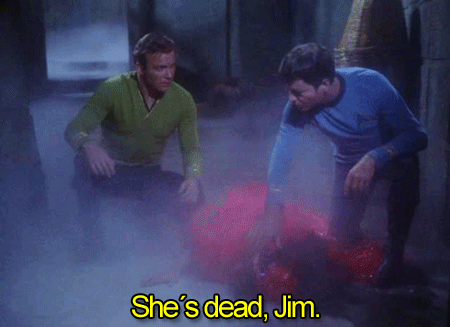
Chloroform does not fuck around. Sure, you can't just knock someone out immediately by putting it over their mouth. But she's been in there for a while, I assume, and she's getting a concentrated dose that's wrapped around her entire face? No ventilation. Yeah, she's dead. Or she's at least got liver failure.
What with actual suffocation, and what with the poisonous fumes of the chloroform, the Lady Frances seemed to have passed the last point of recall. And then, at last, with artificial respiration, with injected ether, and with every device that science could suggest, some flutter of life, some quiver of the eyelids, some dimming of a mirror, spoke of the slowly returning life.
Zombie Lady Frances! The miracle of modern science strikes again.
Get the woman some brandy!
"It is new to me in the annals of crime. If our ex-missionary friends escape the clutches of Lestrade, I shall expect to hear of some brilliant incidents in their future career.”
Super weird note to end on. But I guess hurrah she lived... for however long before the combined liver and kidney failure killed her. But she wasn't dead when they left her, and that's the important thing!
And our villains may or may not escape. Shlessinger's villains to join Shlessinger's Lady Frances, I guess. ACD can't have been making a Schrödinger reference because Schrödinger's cat wouldn't be thought up until decades after this story was published, but it's all very Schrödinger.
19 notes
·
View notes
Text
Bravado on the gallows
[abridged excerpt from V.A.C. Gatrell's The Hanging Tree: Execution and the English People 1770–1868, Chapter 1.1: “Dying Bravely”, emphasis mine]
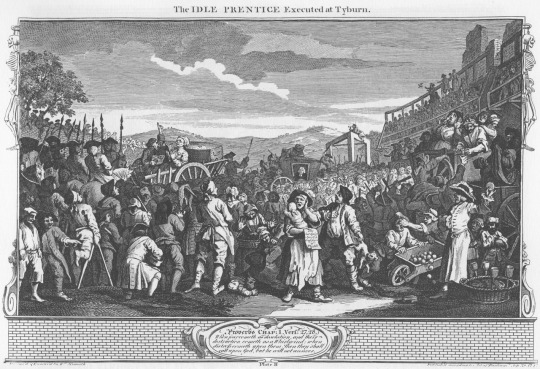
the most iconic depiction of a procession to the Tyburn gallows, with the condemned on a cart going through excited crowds: William Hogarth's The Idle 'Prentice Executed at Tyburn, from the Industry and Idleness series (1747)
In theory, a Londoner growing up in the 1780s could by 1840 have attended some four hundred execution days outside Newgate alone. If he was unimaginably diligent he could have watched 1,200 people hang (and there were such obsessives). The sanction of the gallows and the rhetoric of the death sentence were central to all relations of authority in Georgian England. But the gallows were also embedded in the collective imagination, the subject of anxiety, defence, and denial, of jokes, ballads, images, and satire, and of primal gratifications too.
Even today we take comfort from an exuberant and cheering fantasy of what public hangings were like, and hence blur the memory of what the noose really did to people. A pleasant myth shields us from the reality of the process. It is not that the myth was without basis. It is what it concealed that is in question.
Central to the fantasy is the memory of the felon’s procession to Tyburn before 1783. To surface appearances it all seems rather jolly, and in certain dark senses it was so:
As clever Tom Clinch, while the rabble was bawling, Rode stately through Holborn, to die in his calling; He stopped at the George for a bottle of sack, And promised to pay for it when he came back. – J. Swift, ‘Clever Tom Clinch going to be hanged’ (1726/7)
From Newgate prison the condemned were conveyed in open carts along Holborn, St Giles, and Tyburn Road (later Oxford Street) to the triangular gallows at the foot of the Edgware Road. The major stations in this parodic progress to Calvary were at inns like the Bowl on the corner of St Giles’ High Street, or the George in Holborn, where the condemned would be offered wine; then Tyburn itself; and then again at Surgeon’s Hall at the Old Bailey, where murderers’ bodies were displayed and dissected.
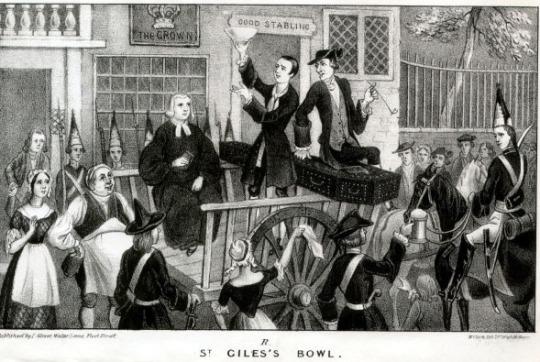
Thief, escape artist, and folk hero Jack Sheppard taking his last drink at St Giles
Playing as best they could to the crowd’s admiration and engaging in parodic dialogue with it, some felons on their way to their doom constructed the illusion that they were the masters of the ceremonies, and not the City marshal, under-sheriff, priest, constables, and javelin-men who were meant to impart solemnity and security to the procession. Lord Ferrers’s composure on his journey to Tyburn in 1760 ‘shamed heroes’, Horace Walpole reported. Hanged for murdering his servant, he bore the procession ‘with as much tranquillity as if he was only going to his own burial, not to his own execution’. Plebeians also put on fine displays:
The vilest rogues, and most despicable villains, may own a thousand crimes, and often brag of the most abominable actions; but there is scarce one, who will confess that he has no courage... The further a man is removed from repentance, nay, the more void he seems to be of all religion, and the less concern he discovers for futurity, the more he is admired by our sprightly people. – B. Mandeville, An enquiry into the causes of the frequent executions at Tyburn (1725)
When Lewis Avershaw was hanged on Kennington Common in 1795 he appeared ‘entirely unconcerned, had a flower in his mouth, his bosom was thrown open, and he kept up an incessant conversation with the persons who rode beside the cart, laughing and nodding to acquaintances in the crowd’. He was afterwards hanged in chains on Wimbledon Common, and ‘for several months, thousands of the London populace passed their Sundays near the spot, as if consecrated by the remains of a hero’. ‘Sixteen-string’ John Rann in 1774 wore a peagreen coat, a nosegay in his buttonhole, and nankeen small-clothes tied at each knee with sixteen strings. At the gallows he sustained the demeanour of his last dinner-party in Newgate, where the company had included seven of his girls and ‘all were remarkably cheerful’. Thanks to the crowds and the convivial exchanges en route, a popular daredevil like this might take two hours to travel the couple of miles to his Tyburn death.

The Newgate Drop in action, 1809
Nor did this festive tradition die when the scaffold was removed to Newgate’s exterior in 1783. At Holloway’s and Haggerty’s hanging in 1807 both men ‘conducted themselves with the most decided indifference’. Holloway ‘with an affected cheerfulness of countenance... jumped upon the scaffold when he had ascended the ladder, his arms being pinioned with a rope behind... got his hat between his two hands, and as well as he was able, bowed to the crowd repeatedly... with a view to show that he died game, as it is expressed.’ He announced his innocence, refused to pray, and told Haggerty to ignore the clergy-man. Ascending the Newgate scaffold in 1829, Thomas Birmingham ‘was instantly greeted by a vast number of girls of dissolute character in the mob, who called out repeatedly—“Good bye, Tom! God bless you, my trump!” In the 1830s the ballad of the condemned Sam Hall conveyed the tone of these scaffold exchanges:
I saw Nellie in the crowd, And I hollered,—right out loud— ‘Say Nellie, ain’t you proud— Damn your eyes’ .
These mocking postures were mainly metropolitan but not exclusively so. Before his execution at York in 1739, Dick Turpin employed five mourners to follow his cart to the scaffold.
Self-parody and the display of courage was one way of dealing with terror. Defiance was another. An agricultural worker executed in Kent for arson during the Swing disturbances in 1830 declared his innocence to the last and ‘refused to pull the cap down over his eyes, saying he wished to see the people’ as he died. Others spurned God and his priests. When the highway robber Norton died game in 1827 he refused religious consolations. When a schoolmaster in Newgate sought to persuade a condemned man that there was a future life, the reply got to the truth of it: “Why you too gammon on as well as the parson! They take your life away, and then they think to make amends by telling you of another and a better world; for my part I am very well satisfied with this, if they will let me stay in it.’

Thomas Rowlandson, Malefactors on Their Way to Tyburn (c. 1776–1827)
Then there was the determined care about dress. Best clothing was worn by those who could afford it. Few men now dressed as Lord Ferrers had in 1760, in his wedding suit of white and silver, or paraded symbols like the white cockade the burglar Waistcott wore in his hat in 1759 ‘as an emblem of his whole innocence’. Male dress was becoming sober. Hatfield wore a black jacket with waistcoat, fustian pantaloons, and white cotton stockings; Fauntleroy ‘a new suit of black, silk stockings of the same colour, and light pumps’. But women continued to affect sartorial gaiety. Elizabeth Fry found that the ‘chief thought’ of nearly every condemned woman in Newgate ‘relates to her appearance on the scaffold, the dress in which she shall be hanged’. When Christian Bowman was hanged and burnt outside Newgate in 1789 she was ‘drest in a clean striped gown, a white ribbon, and a black ribbon round her cap’. In 1815 Eliza Fenning wore the dress she was to have worn for her wedding, a ‘white muslin gown, a handsome worked cap, and laced boots’.
Striking in all this is the victim’s effort to maintain dignity to the last and to die well, by drawing on a supportive vein of cynicism which ran deep in popular culture. Also striking is the authorities’ tolerance of these efforts. Those with money could spend their last days in Newgate in dissipation, as John Rann did, along with the highwayman Paul Lewis in 1763 when he entertained guests in the condemned cell by singing bawdy songs and vilifying the parson. On the scaffold likewise, custom had long entitled the condemned to address the crowd as they pleased, seditiously if they chose. Although every effort was made to force them to public professions of guilt and penitence, they were not checked if they betrayed that role. Jacobites had betrayed the role spectacularly, some making seditious speeches ‘plainly calculated’, as Dudley Ryder had observed, ‘for nothing else but to incense the people against the government... A rogue cannot be hanged but he must become a saint upon the gibbet.’
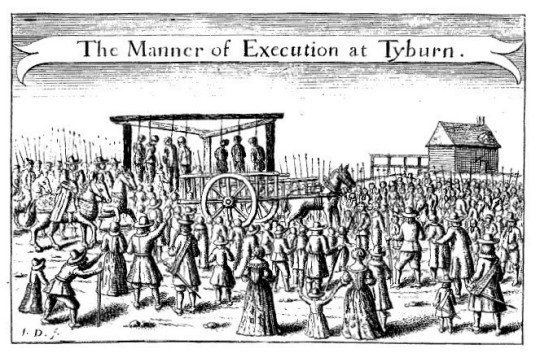
Dr Johnson lamented the abolition of the Tyburn procession: ‘the old method was most satisfactory to all parties; the publick was gratified by a procession; the criminal was supported by it. Why is all this to be swept away?’ This comment is usually taken to indicate bluff Augustan heartlessness. But its key word was ‘support’, and the generosity of Johnson’s observation is clarified in Adam Smith’s amplification of it:
A brave man is not rendered contemptible by being brought to the scaffold. The sympathy of the spectators supports him, and saves him from that shame, that consciousness that his misery is felt by himself only, which is of all sentiments the most insupportable... He has no suspicion that his situation is the object of contempt or derision to any body, and he can, with propriety, assume the air, not only of perfect serenity, but of triumph and exultation.
Johnson’s and Smith’s insights take us at last beyond the jolly surface of these rituals to the bleaker truth which social memory has censored—that most felons went to their deaths in quaking terror. In this light the abolition of the procession and the long shift towards the privatization of execution, commonly understood as a progressive and humane movement, was the reverse of that. To kill felons without ceremony and in private was to deny them the only worldly support they could hope for in their last hours. As evangelicals had their cool say on the best chances of bringing the felon to penitence, the felon was to be left alone with his death, that his spirit might break. [n.b. The author does have a point here (it’s truly horrible to die all alone, without an audience and without your loved ones, at the hands of cops, priests and bureaucrats), but this take ignores that the crowd’s support was not a given; for some they cheered, but for others they cursed, heckled, mocked, threw mud etc]
While public executions lasted, many knew that outward bravado did not speak for a felt reality, and that the powdered wig, Holland shirt, gloves, and nosegays which some flaunted on their last journey was the only resort they had to ‘meliorate the terrible thoughts of the meagre tyrant Death’. The man who did contrive to conduct himself bravely was often actually drunk out of his mind:
But valor the stronger grows, The stronger liquor we're drinking, And how can we feel our woes, When we've lost the trouble of thinking?
— V.A.C. Gatrell, The Hanging Tree: Execution and the English People 1770–1868 (Oxford University Press, 1994)
#V.A.C. Gatrell#theory#swinging from the gallows tree#The Hanging Tree: Execution and the English People 1770–1868#the potatoes of defiance#england#london#I love it when I abridge excerpts#and they're still 17 screens long
36 notes
·
View notes
Text
His residence and principal consulting-room is at Kennington Road, but he has a branch surgery and dispensary at Lower Brixton Road, two miles away. This Dr. Barnicot is an enthusiastic admirer of Napoleon, and his house is full of books, pictures, and relics of the French Emperor.
I don't trust anybody who is an admirer of Napoleon. Huge red flag
#letters from watson#sherlock holmes#the six napoleons#a war and imperialist enthousiast at least#I wonder if Watson knows this doctor
8 notes
·
View notes
Text
CV
SHELLEY THEODORE Born in Brisbane, Australia Lives and works in London, Barcelona and France https://shelleytheodore.tumblr.com/ https://www.axisweb.org/p/shelleytheodore/ EDUCATION 2012 MA Visual Art (Fine Art), Camberwell College of Art, University of the Arts, London 1995 Bachelor of Fine Art (Hons), Goldsmiths College, University of London 1992 Dept of Continuing Education, Goldsmiths College, University of London, Certificate in Art 1980 Bachelor of Social Work, University of Queensland, Australia SELECTED EXHIBITIONS AND PUBLICATIONS 2022 Artist Feature Special Issue: Best Artists of 2022 Magazine 43, Hong Kong 2022 Magazine 43 Film Friday featured artist April 2022 https://magazine43.substack.com 2021 Deptford X Festival, Art in the open Supported Application Guide shapeslewisham introducing@shelley_theodore 23 March 2021 Deptford London 2021 Post Analogue Labyrinth IV, virtual exhibition, https://www.artsteps.com/view/ 6092eeaca33cc06fe89a823f 2019 Post Analogue Labyrinth Ill, as part of DEPTFORD X FRINGE, AAJA Deptford 2018 Post Analogue Labyrinth 11, Sister Midnight Records 4 Tanners Hill London Gaze, Axisweb: Contemporary Art UK Network, online exhibition Aesthetica Issue 81, p157, Artists' Directory, Published on Jan 24,2018 2017 Drawing Open, 26 -28 May, No Format Gallery, Arch 29, Rolt Street, Deptford 2016 Prison Drawing Project, Dean Road Prison, Scarborough, UK Artrooms Fair 2016, Melia Whitehouse Hotel, London 2015 Uncertain States Annual, Mile End Art Pavilion, Mile End 2014 Pala, an online digital program of artist's film and video works curated by Laura Mansfield 2013 Bloomberg New Contemporaries 2013, Spike Island, Bristol, and ICA, London 8 STUDIOS FROM HERE, Faircharm Studios, Deptford Postcard From My Studio, Acme Project Space 44 Bonner Road, Bethnal Green, London 2012 Crash OPEN, Charlie Dutton Gallery, 1a Princeton Street, London The Salon Art Prize Exhibition 2012, Matt Roberts Art, 25b Vyner Street, London Jerwood Drawing Prize Exhibition 2012, Jerwood Space, London No Now, Space Station Sixty Five, Kennington Bend over Shirley, Beaconsfield Contemporary Art 2011 CCW Artist Moving Image, HMV Curzon, Wimbledon 'Chain letter' worldwide exhibition 2011, GIBSMIR family, Zurich, Switzerland. Flash in the Pan, curated by Naomi Sidefin and David Crawford, Beaconsfield Contemporary Art The Unsung Heroes of the studio, ASYLUM, The Chapel, Caroline Gardens, Peckham 2010 Peckham Space Open, Peckham Space, Peckham Deptford X Fringe Award, Deptford X Fringe Nunhead Open Art Exhibition, The Surgery, Nunhead 2009 Creekside Open, selected by Mark Wallinger, APT Gallery, Deptford Creekside Open, selected by Jenni Lomax, APT Gallery, Deptford 2008 London Art Fair, Islington, Beverley Knowles Fine Art 2007 London Art Fair, Islington, Beverley Knowles Fine Art RESIDENCIES 2022 Studio Residency, San Quirze Safaja, Barcelona 2021 Photography Workshop with Architect Lisa Harmey and architecture students University of Cardiff, UK 2015 'Backs to the Future' Residency, FIVE YEARS 66 Richmond Studios, 8 Andrews Road, E84QN 2014 2014 LUX Critical forum, London 2012 Gasworks Curatorial Workshop, Gasworks 2011 Urban fabric 2 (UF2) Paradox Conference, Crawford College of Art and Design, Cork, Ireland 'Sculptural Drawing Collaboration', The Woodmill Project Space, Bermondsey
2 notes
·
View notes
Text
Fight City Gym - Elephant Park

The latest addition to our mixed martial arts training facilities, Fight City Gym now has a location in Elephant & Castle, a short walk from South Bank and Kennington. Our newest gym boasts an impressive 5500sq ft space that is designed to push you to your limits with top of the line facilities and experienced coaches on hand to provide dedicated support.
With an 18ft boxing ring, huge dojo, multi-platform weightlifting area, and so much more, you are guaranteed to be impressed with our new and improved MMA gym in East London.
If you want to get into MMA or improve your current capabilities and are based in Elephant and Castle, Kennington, Borough, Oval, Bermondsey or even Tower Bridge, this gym location is perfect and easy to get to and find.
Whether you want to use our state-of-the-art facilities, take part in one of our many top-rated martial arts classes in Elephant & Castle or seek out the advice of our elite coaches, Fight City Gym in Elephant Park provides a welcoming and supportive environment where you can achieve your fitness goals.
Contact Us
Fight City Gym - Elephant Park
62 New Kent Road, London, SE1 6TJ, United Kingdom
+44 20 7043 6032
https://fightcitygym.co.uk/locations/elephant-park
Find Us On Social Media
Facebook
Instagram
To Know More
Brand Map









1 note
·
View note
Text

FIVE PEDESTRIANS with Child sticker Kennington Park Road SE11
#mister higgs#russell shaw higgs#street art#graffiti#london#stickers#child#crossing#Kennington underground station
1 note
·
View note
Text
The Six Napoleons pt 1
What's better than five Napoleons?
It was no very unusual thing for Mr. Lestrade, of Scotland Yard, to look in upon us of an evening, and his visits were welcome to Sherlock Holmes...
Confirmation of what I was talking about last week. Watson's being nicer about Lestrade in these stories because they're friends now. Love this for them.

On this particular evening Lestrade had spoken of the weather and the newspapers. Then he had fallen silent, puffing thoughtfully at his cigar. Holmes looked keenly at him. “Anything remarkable on hand?” he asked. “Oh, no, Mr. Holmes, nothing very particular.”
Lestrade doing the tried and true 'be pensive and silent, then claim nothing's wrong in order to indicate something is terribly wrong' method of talking to friends here. Very British. A+
“Exactly. That's what I said. But then, when the man commits burglary in order to break images which are not his own, that brings it away from the doctor and on to the policeman.”
OK, everybody please lay your bets on whether the word 'monomaniac' is going to be used in this story.
"The assistant had left the front shop for an instant when he heard a crash, and hurrying in he found a plaster bust of Napoleon, which stood with several other works of art upon the counter, lying shivered into fragments."
Alright, so far so vandalism, I guess. But I do wonder who in early 1900s London was buying and displaying a plaster bust of Napoleon I in their home. Clearly enough people that there are many of them around. But why? Was there some sort of weird Napoleon fashion at the time? I can't imagine him being particularly popular in England even 80 years after his death.
Why are there so many busts of Napoleon around? Who is buying them? Are they some sort of comedy novelty item?
Ho ho ho, here's the guy we fought against, let's stick a silly moustache on him and draw a pair of glasses around his eyes?
"This Dr. Barnicot is an enthusiastic admirer of Napoleon, and his house is full of books, pictures, and relics of the French Emperor."
No, apparently there are just... Napoleon groupies... hanging around.

"One of these he placed in his hall in the house at Kennington Road, and the other on the mantelpiece of the surgery at Lower Brixton. Well, when Dr. Barnicot came down this morning he was astonished to find that his house had been burgled during the night, but that nothing had been taken save the plaster head from the hall."
I fear the other is not long for this world, either. My dude. RIP Napoleon bust.
"...the broken pieces of his second bust were strewn all over the room. It had been smashed to atoms where it stood."
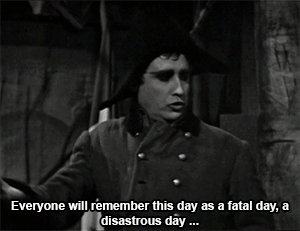
"Considering how many hundreds of statues of the great Emperor must exist in London, it is too much to suppose such a coincidence as that a promiscuous iconoclast should chance to begin upon three specimens of the same bust.”
No, seriously tho... why are there so many statues of Napoleon I in London? So weird.
"On the other hand, this Morse Hudson is the purveyor of busts in that part of London, and these three were the only ones which had been in his shop for years."
That does make me feel better about this whole thing.
“There are no limits to the possibilities of monomania,” I answered.
Ooooh... ooh oooh ooh. So close. Does 'monomania' count? I did say 'monomaniac'.
“That won't do, my dear Watson,” said Holmes, shaking his head; “for no amount of idée fixe would enable your interesting monomaniac to find out where these busts were situated.”
Drink!

"You will remember, Watson, how the dreadful business of the Abernetty family was first brought to my notice by the depth which the parsley had sunk into the butter upon a hot day."
How heavy was that parsley? Surely it would float as the butter melted below it?
Or did they stab the stalk right in there like they were planting a tiny green flag on the newly discovered Butterland?
The development for which my friend had asked came in a quicker and an infinitely more tragic form than he could have imagined. [...] “Come instantly, 131, Pitt Street, Kensington. — “Lestrade.”
I know that he means that the think Lestrade is summoning them to is going to be tragic, but this reads as though the very concept of getting a telegram from Lestrade is the true tragedy.
No. 131 was one of a row, all flat-chested, respectable, and most unromantic dwellings.
Watson, I get that being horny on main is one of your Things™️but why are you talking about the houses' boobs? I don't think houses have mammary glands, my man, and as a medical doctor, even if you're not practising anymore, you really should be aware of that.
I guess this just means that they don't have any bay windows or protrusions on their fronts, and they're just boxy, flat frontages, but what a word to choose.
I guess Baker Street must have big naturals or something.

I can't believe I just typed that with my own two hands. But I'm leaving it there. if I have to think it, you will read it.
“It's the Napoleon bust business again,” said Lestrade. “You seemed interested last night, Mr. Holmes, so I thought perhaps you would be glad to be present now that the affair has taken a very much graver turn.”

I see what you did there, Lestrade.
"Why any burglar should take such a thing passes my understanding, for it was only a plaster cast and of no real value whatever."
So why do you have it? WHY DO ALL THESE PEOPLE HAVE PLASTER BUSTS OF NAPOLEON?
Wasn't he, like, an enemy of the empire? Wasn't it England that imprisoned him on St Helena? What is up with all of this?
"Stepping out into the dark I nearly fell over a dead man who was lying there. I ran back for a light, and there was the poor fellow, a great gash in his throat and the whole place swimming in blood."
Well, that's a situation right out of a horror film.
I like this guy. I hope he doesn't turn out to be the murderer.
It was evidently taken by a snap-shot from a small camera. It represented an alert, sharp-featured simian man with thick eyebrows, and a very peculiar projection of the lower part of the face like the muzzle of a baboon.
Oh no, are we now doing degeneration, Watson? Must we always play around the fringes of eugenics? Watson, please. Must we make the ape comparisons? Must we?
We were doing so well at being nice to Lestrade as well.
"Well, I was the only journalist in the stand, and my journal the only one that had no account of it, for I was too shaken to write it. And now I'll be too late with a murder done on my own doorstep.”
My dude, I love you.
27 notes
·
View notes










